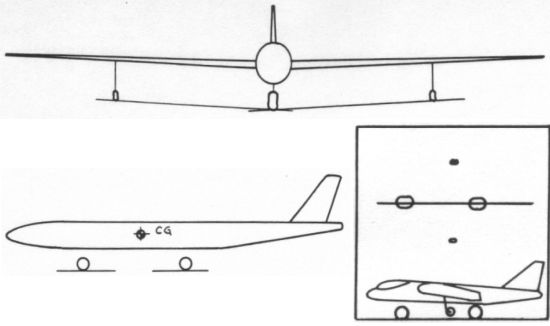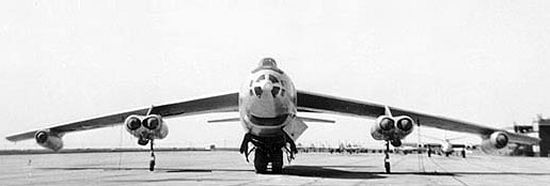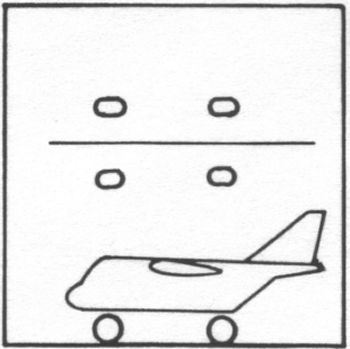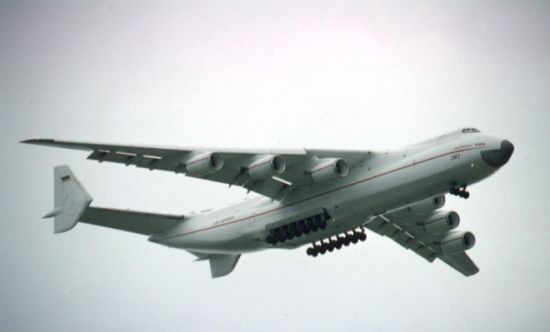Bicycle Gear A relatively uncommon landing gear option is the bicycle undercarriage. Bicycle gear features two main gear along the centerline of the aircraft, one forward and one aft of the center of gravity. Preventing the plane from tilting over sideways are two small outrigger gear mounted along the wing. 
Bicycle landing gear The only real advantage of bicycle gear is lower weight and drag than either the taildragger or tricycle arrangements. Bicycle gear are also useful on planes with very long and slender fuselages where there is little room for more traditional undercarriage arrangements. Unfortunately, bicycle gear are very demanding on the pilot who must maintain a very level attitude during takeoff and landing while carefully managing airspeed. The pilot must also compensate for any rolling motion that could cause the plane to land unevenly on one of the outrigger gear, and crosswinds are particularly difficult to deal with. 
Bicycle landing gear of the B-47 Stratojet Because of these limitations, bicycle gear are generally limited to planes with high aspect ratio wings that generate high lift at low angles of attack. Good examples of such planes are large bombers with a narrow fuselage and large wingspan like the B-47. Another common application of the bicycle undercarriage is aboard vertical takeoff and landing designs like the Harrier. Here, the gear layout provides safety and stability in case of an engine failure during landing. Single Main Gear A special subcategory of the bicycle undercarriage is the single gear. This layout features a single large gear unit and a much smaller auxiliary tailwheel along the centerline. Outriggers are again provided for stability. 
Single main landing gear This design is particularly simple, lightweight, and low drag and may even include skids rather than wheels. This simplicity makes the gear arrangement attractive for use on light planes like gliders and sailplanes, but the single main gear is generally impractical for larger aircraft. 
U-2 Dragon Lady and its landing gear arrangement Perhaps the best known application of a single main gear arrangement is the U-2 reconnaissance plane. This aircraft has a single large gear unit near the center of gravity plus a much smaller tailwheel. Two additional outriggers called "pogos" are attached by ground crew to keep the plane from tipping during taxi, but these are removed prior to takeoff. Quadricycle Gear Quadricycle gear are also very similar to the bicycle arrangement except there are four main gear roughly equal in size and mounted along the fuselage. 
Quadricycle landing gear Like bicycle gear, the quadricycle undercarriage also requires a very flat attitude during takeoff and landing. This arrangement is also very sensitive to roll, crosswinds, and proper alignment with the runway. The most significant advantage of quadricycle gear is that the plane's floor can be very close to the ground for easier loading and unloading of cargo. However, this benefit comes at the price of much higher weight and drag than bicycle gear. 
Quadricycle landing gear of the B-52 Stratofortress Quadricycle gear are sometimes used on cargo planes, but probably the most well known example is the B-52 bomber. This aircraft employs a cross between the quadricycle and bicycle arrangements since it has four main gear plus two small outriggers near the wingtips. Multi-Bogey Gear A final variation that is worth mentioning is the use of multiple wheels per landing gear strut. It is especially common to place two wheels on the nose strut of the tricycle arrangment to provide safety and steering control in case of a tire blowout. This additional tire is particularly useful on carrier-based aircraft where two nosewheels are a requirement. Multiple wheels are also often used on main gear units for added safety, especially on commercial airliners. 
Multi-bogey landing gear When multiple wheels are placed on the same gear unit, they are attached together on a structural device called a bogey. The heavier the aircraft becomes, the more wheels are typically added to the bogey to spread the plane's weight more evenly across the runway pavement. In general, a plane weighing less than 50,000 lb (22,680 kg) has only one wheel per main gear strut. Aircraft weighing up to 200,000 lb (90,720 kg) usually carry two wheels per strut. On planes weighing up to 400,000 lb (181,440 kg), a four-wheel bogey is typical. Aircraft of greater weight often carry four bogeys, each with four to six wheels. 
The many, many, many landing gear wheels of the An-225 The best examples of multi-bogey aircraft are large mega jets like the An-225. This mammoth cargo plane has seven pairs of wheels on each main gear assembly plus four nosewheels, combining for a total of 32 tires! Another good example is the Boeing 747. The 747 is equipped with four main gear units, each with four-wheel bogies, plus twin nosewheels so that the plane's weight is spread across 18 wheels. Summary Landing gear serves three primary purposes--to provide a support for the plane when at rest on the ground, to provide a stable chassis for taxiing or rolling during takeoff and landing, and to provide a shock absorbing system during landing. Regardless, all of these tasks are secondary to the plane's primary role as an efficient mode of travel through the air. To aircraft designers, landing gear are nothing more than a necessary evil since planes are designed primarily for their performance in flight rather than on the ground. There have even been attempts over the years to eliminate landing gear entirely. The most extreme case was a study done by the Royal Navy to see if a jet plane could make a belly landing on the deck of an aircraft carrier coated with a rubberized surface. If successful, the method would eliminate the need for the very strong and heavy landing gear used on carrier-based aircraft. Unfortunately, the method proved impractical, but it shows the lengths some will go to while attempting to eliminate the need for landing gear! We have seen that landing gear come in many varieties and each option has its own advantages and disadvantages. Selecting the best arrangement for a given aircraft is a trade-off between these strengths and weaknesses as they apply to the environment the plane is designed for. As a result, designers try to select the simplest, smallest, lightest, and least expensive solution possible to do the job while maintaining safety. That is why most planes only have three landing gear rather than four because fewer gear weigh less, require less structure aboard the plane, take up less space when retracted, and generate less drag.
- answer by Jeff Scott, 31 October 2004 |
 /1
/1 